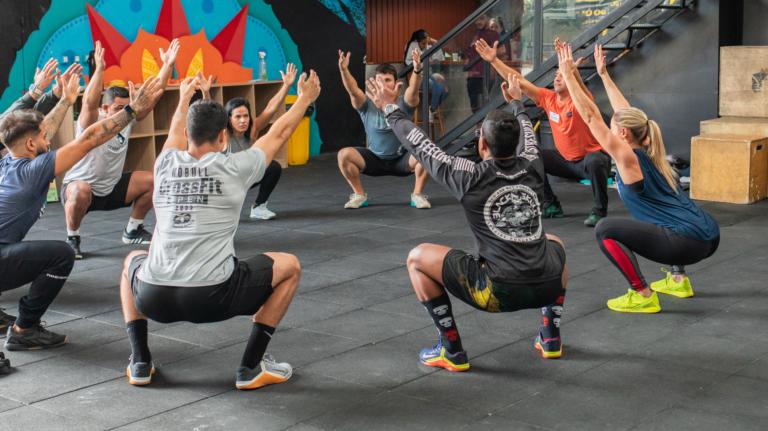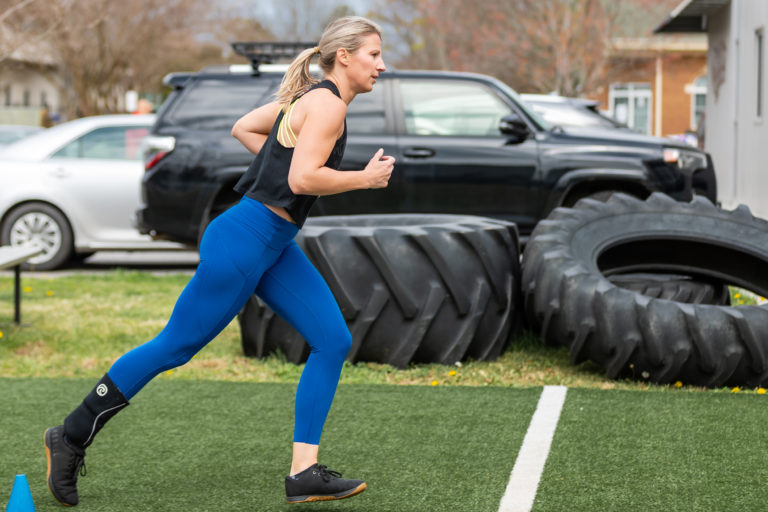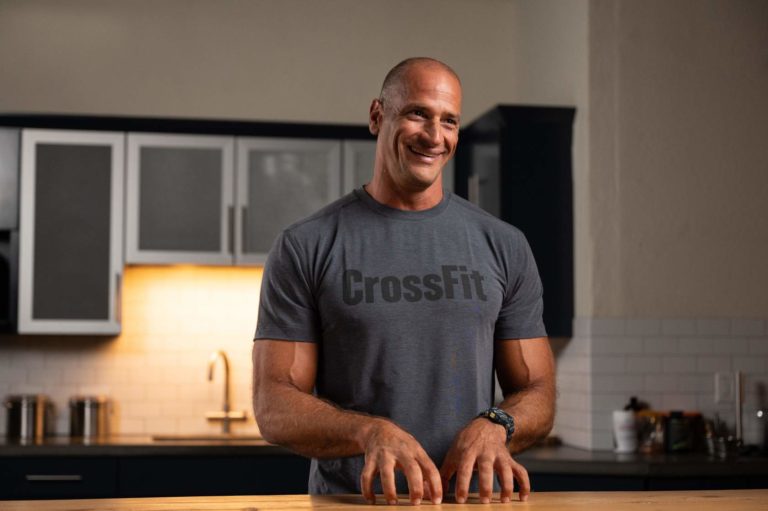Many of us haven’t sprinted — really sprinted — in years, and retrieving this skill seems daunting. We have visions of calf, achilles, and hamstring injuries sidelining us as soon as we step on the gas. And if we haven’t tested our speed in a while, this might just happen. Like everything else we do in CrossFit, implementing sprinting requires following the prudent, safe, and effective process of developing mechanics and consistency before adding intensity.
When we’re learning a new strength movement like a snatch, clean and jerk, or squat, we can train our mechanics with a PVC pipe. The reduced load is the perfect environment to master technique and slowly condition the muscles and joints through the full range of motion we need. Sprinting is more like gymnastics movements because we can’t decrease the load. Each foot contact will bear the brunt of our body weight as we drive forces into the ground. We can’t decrease these loads with bands or spotting like we can with gymnastics movements, so our only option is to decrease speed. But then we’re not really sprinting, are we? The following plan is designed to take an athlete from the “really rusty, haven’t sprinted in a long time” stage to having the capacity to sprint short distances (up to 40 yards or so) at 80% effort or greater with minimal risk. Ready? LFG!
Phase 1: Movement, Mobility, and Special Strength
 The air squat is an excellent assessment of whether we have the mobility and mechanics to sprint safely and effectively. This isn’t about sprint technique, but simply understanding if your body parts can move properly through a sprinting movement pattern. If you can squat to full depth, and, in this bottom position, keep your knees tracking over your toes, your torso tall, and maintain your lumbar curve, you have the system prerequisites to sprint efficiently. Any faults that appear in an air squat are greatly magnified in our sprinting movement pattern, but are much harder to see due to the shorter ranges of motion and much higher velocities. Rest assured, however, if your knees cave in (even slightly), if you can’t achieve a strong bottom position in the squat, or you cannot maintain your midline as you squat, you will be like a car trying to accelerate from 0-60 as fast as possible on flat tires. These issues need to be addressed first.
The air squat is an excellent assessment of whether we have the mobility and mechanics to sprint safely and effectively. This isn’t about sprint technique, but simply understanding if your body parts can move properly through a sprinting movement pattern. If you can squat to full depth, and, in this bottom position, keep your knees tracking over your toes, your torso tall, and maintain your lumbar curve, you have the system prerequisites to sprint efficiently. Any faults that appear in an air squat are greatly magnified in our sprinting movement pattern, but are much harder to see due to the shorter ranges of motion and much higher velocities. Rest assured, however, if your knees cave in (even slightly), if you can’t achieve a strong bottom position in the squat, or you cannot maintain your midline as you squat, you will be like a car trying to accelerate from 0-60 as fast as possible on flat tires. These issues need to be addressed first.
Aside from being able to squat with a full range of motion, incorporating some basic stretching and mobility work for our hips, ankles, hamstrings, calves, and shoulders allows us to better hit the positions we want to express with our stride and arm swing when sprinting. This doesn’t have to be too time-consuming and can be done as part of our general warm-ups and cool-downs or as part of any mobility work we schedule throughout the day. Here are a few exercises many athletes find useful in their progression to reintroduce sprinting:
- Hips: couch stretch and 90/90 hip switch
- Ankles: knee-over-toes squatting or lunging
- Hamstrings: flossing is excellent prep for sprinting
- Calves: smashing and calf stretching
- Shoulders: stretching the lats and pecs is helpful
In addition to being flexible and mobile in the right areas for sprinting, we need to be strong in the joints and muscles that will be driving forces into the ground to propel us forward. The consistent strength training that is such an integral part of CrossFit takes care of this for the most part, but it’s not a bad idea to incorporate a few specialized exercises and drills to prepare the feet, shins, calves, and hips for the training ahead. The sprint drills listed below strengthen the athlete’s structures and have the added benefit of teaching proper mechanics and developing midline stabilization in sprint-specific positions. The core strength achieved from these drills is critical in sprinting to allow for the efficient transfer of forces through arm action to the lower body and into the ground and back up, with every stride.
Tibialis raises and straight leg and bent leg calf raises, both double-leg and single-leg versions, help with foot dorsiflexion (pulling the toes toward the shin), which is so important in sprinting. They also protect the Achilles tendon, calves, knees, and hips. The stronger the lower leg is at accepting and transmitting forces into the ground, the better for the knees and hips.
Tony Holler is a world-class sprint coach who epitomizes the CrossFit philosophy of doing what works and prizing intensity over volume. He uses the following drills to prepare his athletes for their sprints:
- Fast march
- A-skip
- High knees
- 5 box (or Tuck) Jumps
- Bounds
- Pogo jumps
- High-frequency prime times, big prime times, or bent-knee prime times
- One or two accelerations
 Set two cones 15 yards apart and do the drills in between. Athletes walk back to the start line and reset before starting the next drill. One time through on each drill is sufficient. The big coaching cues for the athletes are “tall posture,” “drive the elbow back,” and “drive the knee down.” We’ll have a more in-depth look at sprint technique in another article, but these cues are a great start for mastering these drills. Coach Holler also insists that for these drills to be effective, the athletes must do them as if they are highly caffeinated. All-out effort (within proper technique) is critical.
Set two cones 15 yards apart and do the drills in between. Athletes walk back to the start line and reset before starting the next drill. One time through on each drill is sufficient. The big coaching cues for the athletes are “tall posture,” “drive the elbow back,” and “drive the knee down.” We’ll have a more in-depth look at sprint technique in another article, but these cues are a great start for mastering these drills. Coach Holler also insists that for these drills to be effective, the athletes must do them as if they are highly caffeinated. All-out effort (within proper technique) is critical.
These drills should be incorporated into warm-ups two to three times a week on an ongoing basis to prepare athletes to sprint.
Phase 1 should last approximately one month.
Phase Two: Hill Sprints, Stairs, or Belly Sprints
The habits we’ve developed in Phase 1 remain in Phase 2, and now we add some actual sprinting. In an ideal world, we would have easy access to stairs or a hill to sprint up. After the speed drill warm-up, we would do 3 to 5 20- to 30-yard sprints up the hill or stairs with 2-3 minutes rest in between each rep. If there’s no practical access to stairs or a hill, athletes can do belly sprints. After the warm-up, athletes perform 5 to 10 all-out 10-yard belly sprints with a 1-minute rest in between. Over a few weeks, this distance can be increased to 20 yards.
Another drill that is great for this phase, where we’re introducing sprinting but still limiting the distance and velocity achieved, is the Hansen Drill, explained here. This drill is great for conditioning our muscles, tendons, and ligaments for more strenuous, max-velocity sprinting to come.
Phase 2 lasts two to four weeks, with distances for hill sprints or belly sprints increasing from 10 to 20 or 30 yards over that time, or reps in the Hansen Drill increasing from 2 to 4 or even 5.
Phase 3: It’s on!
In this Phase 3, we program sprint workouts. The sprints should be fast (anywhere from 80%-95%+ effort), display excellent technique, and include LONG rest periods. These workouts should be low volume. A 10-minute EMOM of 100-meter sprints is not a sprint workout. Holler has his track athletes run three timed 40-yard sprints for a workout, with 3-5 minutes rest in between each rep. That’s enough to become very good at sprinting. And the benefits in terms of strength, power, and nervous system adaptation are amazing.
Sample Sprint Day WOD:
- Standard CrossFit dynamic mobility warm-up
- Speed drills (finish with a couple accelerations)
- Three 40-yard sprints, timed. Run smoothly and relaxed at 80-85% effort on the first one. Then, if everything feels good, nudge the speed up by driving your elbows back harder and punching the ground with the forefoot a little harder on each stride. Make sure to get full recovery between reps (3-5 minutes)! A little word of caution: race the clock, not other people. When we race others and we see them pull ahead of us or they are catching up to us, we tend to forget our technique, tighten up in the shoulders, and overstride. This leads to hamstring and hip pulls.
By programming one speed day a week while incorporating the speed drills in warm-ups regularly, athletes will obtain all the dividends sprinting provides. Sprinting as a regular part of CrossFit programming will help push the needle toward elite fitness.
For more on sprinting, check out my conversation with Eric O’Connor (CF-L4). We break down all of the phases, why we need them, and how to keep sprinting a part of your routine.
About the Author
 Stephane Rochet is a Senior Content Writer for CrossFit. He has worked as a Flowmaster on the CrossFit Seminar Staff and has over 15 years of experience as a collegiate/tactical strength and conditioning coach. He is a Certified CrossFit Trainer (CF-L3) and enjoys training athletes in his garage gym.
Stephane Rochet is a Senior Content Writer for CrossFit. He has worked as a Flowmaster on the CrossFit Seminar Staff and has over 15 years of experience as a collegiate/tactical strength and conditioning coach. He is a Certified CrossFit Trainer (CF-L3) and enjoys training athletes in his garage gym.